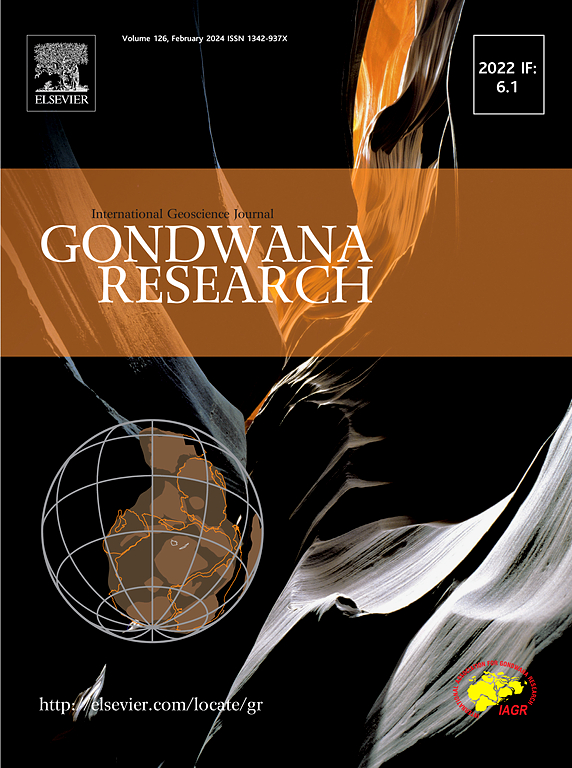Mapping a 300-million-year old glacier bed: The Noordoewer section, Orange River, Namibia
IF 7.2
1区 地球科学
Q1 GEOSCIENCES, MULTIDISCIPLINARY
引用次数: 0
Abstract
Glacial geomorphological structures produced during the Late Palaeozoic Ice Age (LPIA) of Namibia provide exceptional insight into the flow direction, flow behaviour, and plumbing of subglacial drainage systems in deep time. At Noordoewer (southern Namibia), along the Orange River, a unique and largely undocumented ∼300 Ma assemblage of subglacial structures within the Dwyka Group is investigated. A detailed geological map documents a complex array of both hard- and soft-bed features shaped by the combined action of subglacial abrasion and meltwater. Structures trend parallel to the Orange River, supporting the view that part of its course originated as a Late Carboniferous valley. Key glacial indicators in a hard bedrock area developed on the Nama Group (Ediacaran metasediments) include (i) striated pavements, (ii) multiple roches moutonnées, and (iii) meltwater channels / p-forms. In areas comprising either a veneer or sheet of sandy diamictite, additional soft subglacial bed features are recognised, including (iv) a flute field, (v) soft-sediment striated surfaces (SSSS) and (vi) glaciotectonic structures including deformation bands. Collectively, these six sets of features support a NNW-directed palaeoflow, in direct contrast to previous interpretations of a southward or westward glacial flow down the axis of the Karasburg Basin. Thus, the new findings have broad implications for reconstructing past ice sheet dynamics and interpreting the geological record of glacial landscapes in the Late Palaeozoic record.

绘制3亿年前的冰川床:纳米比亚奥兰治河Noordoewer部分
在纳米比亚晚古生代冰期(LPIA)产生的冰川地貌结构为深入了解冰下排水系统的流动方向、流动行为和管道提供了独特的见解。在Noordoewer(纳米比亚南部),沿着橙河,研究了Dwyka群中一个独特的、大部分没有记录的~ 300 Ma冰下结构组合。一张详细的地质图记录了一系列复杂的由冰下磨损和融水共同作用形成的软硬层特征。构造倾向于与奥兰治河平行,支持其部分河道起源于晚石炭世山谷的观点。在Nama群(Ediacaran沉积层)上发育的硬基岩区,主要的冰川指标包括:(i)条状路面,(ii)多岩洞山口,(iii)融水通道/ p型。在含有砂质二晶岩单板或片层的地区,可以识别出额外的软冰下床特征,包括(iv)长笛场,(v)软沉积条纹面(SSSS)和(vi)包括变形带在内的冰川构造构造。总的来说,这六组特征支持北西向的古流动,与之前关于卡拉斯堡盆地轴向南或向西的冰川流动的解释形成鲜明对比。因此,这些新发现对于重建过去的冰盖动力学和解释晚古生代冰川景观的地质记录具有广泛的意义。
本文章由计算机程序翻译,如有差异,请以英文原文为准。
求助全文
约1分钟内获得全文
求助全文
来源期刊

Gondwana Research
地学-地球科学综合
CiteScore
12.90
自引率
6.60%
发文量
298
审稿时长
65 days
期刊介绍:
Gondwana Research (GR) is an International Journal aimed to promote high quality research publications on all topics related to solid Earth, particularly with reference to the origin and evolution of continents, continental assemblies and their resources. GR is an "all earth science" journal with no restrictions on geological time, terrane or theme and covers a wide spectrum of topics in geosciences such as geology, geomorphology, palaeontology, structure, petrology, geochemistry, stable isotopes, geochronology, economic geology, exploration geology, engineering geology, geophysics, and environmental geology among other themes, and provides an appropriate forum to integrate studies from different disciplines and different terrains. In addition to regular articles and thematic issues, the journal invites high profile state-of-the-art reviews on thrust area topics for its column, ''GR FOCUS''. Focus articles include short biographies and photographs of the authors. Short articles (within ten printed pages) for rapid publication reporting important discoveries or innovative models of global interest will be considered under the category ''GR LETTERS''.
 求助内容:
求助内容: 应助结果提醒方式:
应助结果提醒方式:


